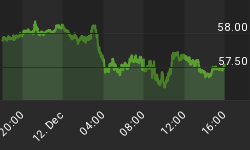As we head into a very busy week of economic data, the bond market remains drippy with the 10-year yield up to 2.59%. (Just writing that makes me laugh. Who would have thought, only a few years ago, that 2.59% was a high-ish yield?)
How we got here, from the ultra-low levels of the last two years, is well-traveled territory. The Fed's swing from "QE-infinity" to "someday, maybe, we might not buy as many bonds" helped trigger a run for the exits, and then negative convexity inflection points kept the rout going for a long time. Most lately, the threat of muni bond convexity has been looming as the next big concern.
But my message today is actually one of good cheer. The worst of the bond selloff was now more than three weeks ago, without a further low being established. In my experience, convexity-inspired selloffs typically end not with a sharp rebound but with a sideways trade as "trapped" long positions gradually work their way out and buyers start to nibble. But it remains a buyer's market for several weeks, at least.
We are getting far enough along in that process that I suspect we have a rally due. This has nothing to do with any economic data coming up. There is enough data coming this week, from Consumer Confidence to Payrolls to GDP to the Fed statement, that both bulls and bears will be able to find something to point to. And I am not pointing to technicals, exactly. I am just saying that markets rarely move in a straight line, and even bear markets - such as the one I think we have now entered, in bonds - have nice rallies from time to time.
But here's a reason to expect this to happen relatively soon. The chart below is a neat "seasonal heat map" chart from Bloomberg showing the monthly yield change for the last 10 years and the average monthly change on the top line.
For a long time, I have been following the rule of thumb I learned as a mere babe in the bond market, and that's that the best time of the year to buy bonds is the first few days of September. From at least the late 1970s until today, September until mid-October has been the strongest seasonal period of the year (not every year, but with enough consistency that you wanted to avoid being short in September). But the heat map above shows that this tendency may have shifted. The month that has seen the best average bond market performance over the last decade has been August, with yields falling an average of 22bps with rallies in 8 of the last 10 years. If we were sitting with 10-year yields at 1.59%, I would be less interested in this observation, but at 2.59% I am looking for the counter-trade.
To be sure, yields in the big picture are headed higher, not lower. But I am looking for signs that the recent selloff has over-discounted the immediate threat of ebbing Federal Reserve purchases. And I don't expect growth to suddenly leap forward here, either.
As an aside, 10-year TIPS yields have also experienced one of their best months in August, with the other clear positive month being January. But, because nominal yields have been so strong, August has been the worst month for breakevens, with 10-year breakevens falling 10bps on average over the last ten years. No other month has seen breakevens decline as much as 6bps, on average.
Now, although I am a bond bear in the big picture, I don't think that the housing market is doomed because interest rates will go up one or two or three percent. I am fascinated by how many analysts seem to think that unless 10-year rates are below 3%, the housing market will collapse. I argued about six weeks ago that higher mortgage rates should not impact sales of homes very much as long as the interest rate is less than the expected capital gain the homeowner expects to make on the home. (Higher rates will, however, cut fairly quickly into speculative building activity, which is much more rates-sensitive). And here is another reason not to worry too much about the housing market. A story in Bloomberg last week says that adjustable-rate mortgages are booming again, with mortgagees taking them out at the highest pace since 2008. Faced with higher rates, and a Fed with is not likely to raise short rates for a long while - as they have taken pains to keep reminding us - homebuyers have rationally decided to take the cheaper money and let the future refinancing take care of itself.
Whether that is sowing the seeds of a future debacle I will leave to other pundits to debate. From my perspective, the important point is that higher rates are not likely to slow home sales, or the recent rise in home prices, very much...unless they get a lot higher.
















